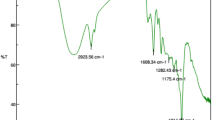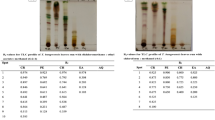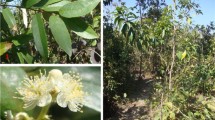Abstract
Antibiotic resistance and the hazardous nature of synthetic drugs is threatening issue in the health sector. The alternative for this problem is to focus on plants that attribute to various compounds that exhibit therapeutic properties. Therefore, the study aims to evaluate the antimicrobial efficacy of Salacia oblonga leaf and root extracts against tested human pathogens. The S. oblonga extracts showed a significant zone of inhibition against bacteria and fungi. The leaf and root extracts of S. oblonga are prepared using low polar to high polar solvents in the Soxhlet apparatus and tested on the selected bacterial and fungal strains. Agar well diffusion and broth dilution methods evaluate antibacterial activity, antifungal activity, and Minimum Inhibitory Concentration (MIC) of extracts. Among the extracts tested, the ethyl acetate extract of root showed more antimicrobial activity against the tested bacterial and fungal strains. The most susceptible bacterial and fungal species against ethyl acetate extract are Micrococcus luteus, Mycobacterium tuberculosis, Microsporum canis, Trichophyton interdigitale, and Microsporum gypseum. The MIC for bacteria ranged from 13.0 to > 200 µg/ml, whereas for fungi, the MIC ranged from 25.9 to > 200 µg/ml. Ethyl acetate extract of root with 100 µg/ml concentration showed 29.1 mm and 28.7 mm zone of inhibition against bacterial strains M. luteus and M. tuberculosis, respectively. The ethyl acetate extract of root with a 100 µg/ml concentration showed 15.8, 15.2, and 15.6 mm zone of inhibition against fungal isolates M. canis, T. interdigitale, and M. gypseum, respectively. The activity of root and leaf extracts increased in a concentration-dependent manner, and further, the compounds isolated from the crude extracts of leaf and root showed antimicrobial activity. Structural elucidation of isolated compounds Lambertic acid and Ferruginol was done using NMR spectroscopy. Reports indicate that Lambertic acid was isolated previously, but the isolation of hydroxy Ferruginol from S. oblonga leaf extract was reported unprecedented.
Similar content being viewed by others
References
Challa S, Mohana Sheela G, Neelapu NRR (2018) Understanding the bacterial biofilm resistance to antibiotics and immune evasion. In: Veera Bramha Chari P (ed) Implication of quorum sensing system in biofilm formation and virulence. Springer, Geneva, pp 369–381
Surekha C, Neelapu NRR (2018). In: Bramha Chari PV (ed) Implication of quorum sensing system in biofilm formation and virulence. Springe, Cham, pp 277–286
Challa S, Dutta T, Pallaval VBC, Neelapu NRR (2019). In: Bramha Chari PV (ed) Implication of quorum sensing and biofilm formation in medicine, agriculture and food industry. Springer, Basel, pp 101–119
Fair RJ, Tor Y (2014) Antibiotics and bacterial resistance in the 21st century. Perspect Med Chem 6:25–64
Li B, Webster TJ (2018) Bacteria antibiotic resistance: new challenges and opportunities for implant-associated orthopedic infections. J Orthop Res 36(1):22–32
Weitzman I, Summerbell RC (1995) The dermatophytes. Clin Microbiol Rev 8(2):240–259
Njateng GSS, Gatsing D, Mouokeu RS, Lunga PK, Kuiate J-R (2013) In vitro and in vivo antidermatophytic activity of the dichloromethane-methanol (1:1 v/v) extract from the stem bark of Polyscias fulva hiern (araliaceae). BMC Complement Altern Med 13(1):1–10
Khan TI, Dular AK, Solomon DM (2003) Biodiversity conservation in the thar desert; with emphasis on endemic and medicinal plants. Environmentalist 23(2):137–144
Balick MJ, Cox PA (1996) Plants, people, and culture: The science of ethnobotany. Scientific American Library, New York
Douglas Kinghorn A (2001) Pharmacognosy in the 21st century. J Pharm Pharmacol 53(2):135–148
Newman DJ, Cragg GM, Snader KM (2000) The influence of natural products upon drug discovery. Nat Prod Rep 17(3):215–234
Chovanová R, Mikulášová M, Vaverková Š (2013) In vitro antibacterial and antibiotic resistance modifying effect of bioactive plant extracts on methicillin-resistant Staphylococcus epidermidis. Int J Microbiol 2013:7609–7669
Musini A, Rao MJP, Giri A (2013) Phytochemical investigations and antibacterial activity of Salacia oblonga wall ethanolic extract. Ann Phytomed 2(1):102–107
Musini A, Giri A (2015) Antibacterial principles of Salacia oblonga wall extracts against drug resistance pathogens. Int J Sci Res 4(8):338–340
Deepak K, Nageswara Rao Reddy N, Challa S (2014) Role of antidiabetic compounds on glucose metabolism–a special focus on medicinal plant: Salacia sps. Med Chem 4(3):373–380
Deepak KGK, Challa S, Suhasin G, Nagesewara Rao Reddy N, Elansary HO, El-Ansary DO (2020) Antidiabetic and antilipidemic activity of root extracts of Salacia oblonga against streptozotocin-induced diabetes in wistar rats. Processes 8(3):301
Uthirapathy S, Ahamad J, Muath Sh, Ameen M (2021) Safety standards and antimicrobial activity of root of Salacia reticulata. Res J Phytochem 15:30–40
Manju S, Moorthy K (2021) In vitro study of antimicrobial activity of Salacia chinensis against Methicilin Resistance Staphylococcus aureus (MRSA). Gorteria J 34(1):410–413
Deepak K, Suneetha G, Surekha C (2015) In vitro clonal propagation of Salacia oblonga Wall. An endangered medicinal plant. Ann Phytomed 4(2):67–70
Srikanth R, Murali Krishna T, Harish Rao B, Surekha C (2020) Anti-biofilm activity and time kill kinetic effects of Salacia oblonga wall leaf and root extracts against clinical multi-drug resistance bacteria. Biomedicine 40(3):347–352
Musini A, Jayaram Prakash Rao Giri A (2015) Phytochemicals of Salacia oblonga responsible for free radical scavenging and antiproliferative activity against breast cancer cell lines (MDA-MB-231). Physiol Mol Biol Plants 21(4):583–590
Musini A, Gandi S, Rao K, Giri A (2016) HPLC polyphenolics profile and H2O2 induced cytoprotective effect of Salacia oblonga extracts on human lymphocytes. Advances in Biological Chemistry 6:19–27
Azoro C (2000) Anti-bacterial activity of crude extract of Azadirachita indica on Salmonella typhi. World J Biotechnol 3:347–351
Janovska D, Kubikova K, Kokoska L (2003) Screening for antimicrobial activity of some medicinal plants species of traditional chinese medicine. Czech J Food Sci 21(3):107–110
Andrews JM (2001) Determination of minimum inhibitory concentrations. J Antimicrob Chemother 48:5–16
Nikaido H (2009) Multidrug resistance in bacteria. Ann Rev Biochem 78:119–146
Rao MJP, Archana G (2010) Antimicrobial activity of the extracts of Salacia oblonga wall. Rec Res Sci Technol 2(10):1–4
Papitha N, Jayshree N, Seenivasan S, Kumar V (2013) Anti-tubercular activity on leaves and roots of Sida rhombifolia L. Int J Pharm Sci Rev Res 20(2):135–137
Kahaliw W, Aseffa A, Abebe M, Teferi M, Engidawork E (2017) Evaluation of the antimycobacterial activity of crude extracts and solvent fractions of selected ethiopian medicinal plants. BMC Complement Altern Med 17(1):143
Selladurai BM, Sivakumaran S, Aiyar S, Mohamad AR (1993) Intracranial suppuration caused by Micrococcus luteus. Br J Neurosurg 7(2):205–207
Moellering RC Jr (1998) The specter of glycopeptide resistance: current trends and future considerations. Am J Med 104(5):3S-6S
Surewaard BG, Thanabalasuriar A, Zeng Z, Tkaczyk C, Cohen TS, Bardoel BW, Jorch SK, Deppermann C, Wardenburg JB, Davis RP (2018) Α-toxin induces platelet aggregation and liver injury during Staphylococcus aureus sepsis. Cell Host Microbe 24(2):271–284
Ena J, Dick RW, Jones RN, Wenzel RP (1993) The epidemiology of intravenous vancomycin usage in a university hospital: a 10-year study. JAMA 269(5):598–602
Bassyouni RH, Kamel Z, Megahid A, Samir E (2012) Antimicrobial potential of Licorice: leaves versus roots. Afr J Microbiol Res 6(49):7485–7493
Ugochukwu AE, John DE, Amin AF, Chidi E, Nwobodo NN, Ogbonna OR, Peter OI, Nnamdi EI (2018) Bacteriostatic and bactericidal effects of ethyl acetate root bark extract of Terminalia avicennioides on methicillin-resistant Staphylococcus aureus. Afr J Biochem Res 12(5):45–54
Edberg S (1991) US EPA human health assessment: Bacillus subtilis. Unpublished. US Environmental Protection Agency, Washington, DC
Gill DM (1982) Bacterial toxins: a table of lethal amounts. Microbiol Rev 46(1):86–94
Bryce A, Hay AD, Lane IF, Thornton HV, Wootton M, Costelloe C (2016) Global prevalence of antibiotic resistance in paediatric urinary tract infections caused by Escherichia coli and association with routine use of antibiotics in primary care: systematic review and meta-analysis. BMJ 352:i939
Elisha IL, Botha FS, McGaw LJ, Eloff JN (2017) The anti-bacterial activity of extracts of nine plant species with good activity against Escherichia coli against five other bacteria and cytotoxicity of extracts. BMC Complement Altern Med 17(1):133
Naeim H, El-Hawiet A, Abdel Rahman RA, Hussein A, El Demellawy MA, Embaby AM (2020) Antibacterial activity of Centaurea pumilio l. Root and aerial part extracts against some multidrug resistant bacteria. BMC Complement Med Ther 20(1):79
Maxwell A (1997) DNA gyrase as a drug target. Trends Microbiol 5(3):102–109
Polikanov Yury S, Aleksashin Nikolay A, Bertrand B, Wilson DN (2018) The mechanisms of action of ribosome-targeting peptide antibiotics. Front Mol Biosci. https://doi.org/10.3389/fmolb.2018.00048
Lin J, Zhou D, Steitz TA, Polikanov YS, Gagnon MG (2018) Ribosome-targeting antibiotics: modes of action, mechanisms of resistance, and implications for drug design. Annu Rev Biochem 20(87):451–478. https://doi.org/10.1146/annurev-biochem-062917-011942
Bavington C, Page C (2005) Stopping bacterial adhesion: A novel approach to treating infections. Respiration 72(4):335–344
Brandt CW, Neubauer LG (1939) 221. Miro resin Part i. Ferruginol. J Chem Soc 221:1031–1037
González MA, Clark J, Connelly M, Rivas F (2014) Antimalarial activity of abietane ferruginol analogues possessing a phthalimide group. Bioorg Med Chem Lett 24(22):5234–5237
Ulubelen A, Birman H, Öksüz S, Topçu G, Kolak U, Barla A, Voelter W (2002) Cardioactive diterpenes from the roots of Salvia eriophora. Planta Med 68(09):818–821
Ono M, Yamamoto M, Masuoka C, Ito Y, Yamashita M, Nohara T (1999) Diterpenes from the fruits of Vitex rotundifolia. J Nat Prod 62(11):1532–1537
Samoylenko V, Dunbar DC, Gafur MA, Khan SI, Ross SA, Mossa JS, El-Feraly FS, Tekwani BL, Bosselaers J, Muhammad I (2008) Antiparasitic, nematicidal and antifouling constituents from Juniperus berries. Phytother Res 22(12):1570–1576
Espinoza M, Santos LS, Theoduloz C, Schmeda-Hirschmann G, Rodríguez JA (2008) New gastroprotective ferruginol derivatives with selective cytotoxicity against gastric cancer cells. Planta Med 74(8):802–808
Rodríguez J, Theoduloz C, Yáñez T, Becerra J, Schmeda-Hirschmann G (2006) Gastroprotective effect of the diterpene ferruginol in mice: Protection against membrane lipid peroxidation and involvement of prostaglandins. Life Sci 78:2503–2509
Bispo de Jesus M, Zambuzzi WF, Ruela de Sousa RR, Areche C, Santos de Souza AC, Aoyama H, Schmeda-Hirschmann G, Rodríguez JA, de Souza M, Brito AR, den Peppelebosch MP, den Hertog J, de Paula E, Ferreira CV (2008) Ferruginol suppresses survival signaling pathways in androgen-independent human prostate cancer cells. Biochimie 90(6):843–854
Jaiswal R, Beuria TK, Mohan R, Mahajan SK, Panda D (2007) Totarol inhibits bacterial cytokinesis by perturbing the assembly dynamics of FtsZ. Biochemistry 46:4211–4220
Muroi H, Kubo I (1996) Antibacterial activity of anacardic acid and totarol, alone and in combination with methicillin, against methicillin-resistant Staphylococcus aureus. J Appl Bacteriol 80:387–394
Constantine GH, Karchesy JJ, Franzblau SG, LaFleur LE (2001) Totarol from Chamaecyparis nootkatensis and activity against Mycobacterium tuberculosis. Fitoterapia 72:572–574
Smith EC, Kaatz GW, Seo SM, Wareham N, Williamson EM, Gibbons S (2007) The phenolic diterpene totarol inhibits multidrug efflux pump activity in Staphylococcus aureus. Antimicrob Agents Chemother 51:4480–4483
Gao Y, Xu X, Chang S, Wang Y, Xu Y, Ran S et al (2015) Totarol prevents neuronal injury in vitro and ameliorates brain ischemic stroke: potential roles of Akt activation and HO-1 induction. Toxicol Appl Pharmacol 289:142–154
Shi C, Che M, Zhang X, Liu Z, Meng R, Bu X, Ye H, Guo N (2018) Antibacterial activity and mode of action of totarol against Staphylococcus aureus in carrot juice. J Food Sci Technol 55(3):924–934
Li Y, Xiang Q, Zhang Q, Huang Y, Su Z (2012) Overview on the recent study of anti-microbial peptides: origins, functions, relative mechanisms and application. Peptides 37:207–215
Acknowledgements
RS, CS, VP, and NNR would like to thank GITAM (Deemed to be University) for providing necessary facilities and support.
Funding
The work was not supported by any funding agency.
Author information
Authors and Affiliations
Contributions
RS, CS designed the study; RS, TM performed the experiments. RS, TM, CS, NNR, and VP analyzed the data and drafted the manuscript.
Corresponding author
Ethics declarations
Conflict of interest
The authors declare that they have no conflict of interest.
Additional information
Publisher's Note
Springer Nature remains neutral with regard to jurisdictional claims in published maps and institutional affiliations.
Supplementary Information
Below is the link to the electronic supplementary material.
Rights and permissions
About this article
Cite this article
Surekha, C., Srikanth, R., Thupurani, M.K. et al. Antimicrobial Activities of Salacia oblonga Wall Leaf and Root Extracts Against Different Bacterial Strains and Fungal Isolates. Curr Microbiol 79, 204 (2022). https://doi.org/10.1007/s00284-022-02888-4
Received:
Accepted:
Published:
DOI: https://doi.org/10.1007/s00284-022-02888-4




